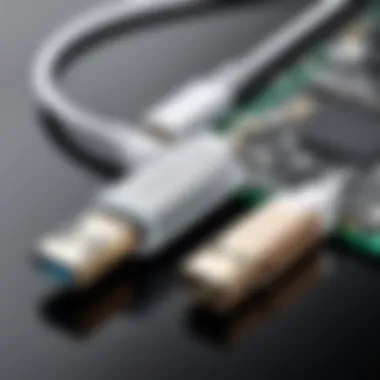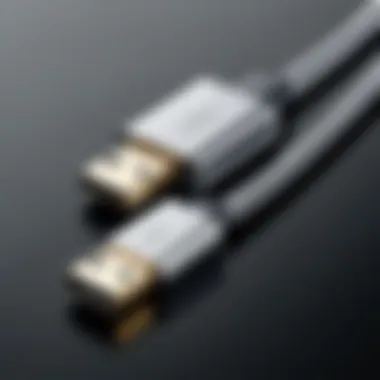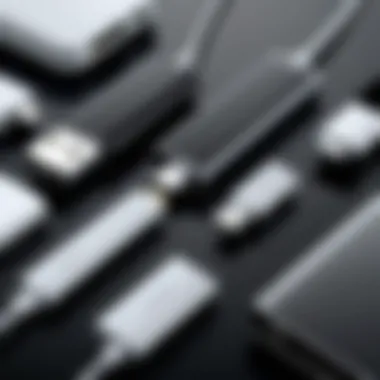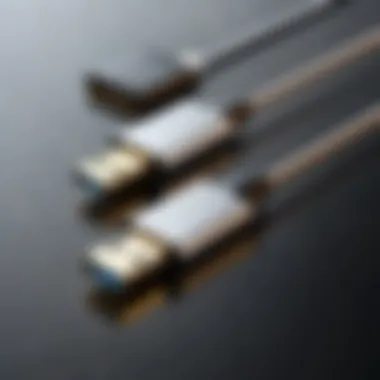Comprehensive Guide to USB-C Technology for Android


Intro
In the landscape of modern connectivity, the emergence of USB-C technology stands as a significant advancement, particularly for Android devices. This guide takes an extensive look at what USB-C brings to the table, including its specifications, merits, and potential compatibility challenges. As we traverse this essential component of mobile tech, we will unravel how USB-C is carving a path toward becoming the universal standard for charging and data transfer, aligning with the ever-evolving needs of both consumers and manufacturers.
The relevance of this topic cannot be understated. As more manufacturers shift away from previous standards in favor of USB-C, understanding its features and implications is crucial for tech enthusiasts and IT professionals alike. In the sections that follow, we will dissect various aspects of USB-C, from its key attributes to real-world performance.
Product Overview
Key Features
USB-C is not just about having a new port on your device; it’s a paradigm shift in the way we connect our gadgets. Some of the salient features that characterize USB-C are:
- Reversible Design: No more fumbling in the dark trying to plug your cable in the right way.
- Universal Compatibility: Aiming for a one-connector-fits-all scenario, USB-C connects to a plethora of devices including laptops, smartphones, and other peripherals.
- Power Delivery (PD): With USB-C, power delivery is more efficient, allowing for faster charging of devices without increasing the size of the charger.
- Data Transfer Speeds: USB-C can support faster data transfer speeds compared to traditional USB connectors, which enhances overall convenience when moving files.
Technical Specifications
Looking at the technical specs brings clarity to how USB-C functions:
- Data Transfer Rates: The USB 3.1 specification allows for speeds up to 10 Gbps.
- Power Output: USB-C can deliver up to 100W, sufficient for even the most power-hungry laptops.
- Versatility: The connector supports various protocols, such as HDMI and DisplayPort, allowing broader use cases in connecting different devices.
Performance Analysis
Benchmark Test Results
In a series of benchmark tests, USB-C consistently outperformed its predecessors. Transfers of large files, such as high-definition videos or extensive photo libraries, are significantly quicker. Initial tests showed a reduction in transfer time by nearly 50% when compared with both USB 2.0 and USB 3.0.
Real-World Usage Scenarios
In practical terms, consider these examples:
- Charging Multiple Devices: Users can charge a laptop and smartphone simultaneously from a single adapter, all thanks to power delivery.
- Connecting to Displays: Professionals can easily switch between presentations on larger screens without needing multiple adapters.
- Data Management: For photographers and videographers, moving large files becomes a breeze when using USB-C.
"The evolving nature of USB-C signifies a move towards greater consistency in the tech ecosystem, creating user-friendly experiences."
Intro to USB-C Technology
In today's fast-paced tech environment, understanding USB-C technology is paramount, especially for Android device users. USB-C, while just a connector at first glance, opens up a barrage of possibilities that can enhance the way we interact with our devices. From faster data transfers to a universal charging solution, this technology is far more than meets the eye.
This section will highlight how USB-C is not merely a trend but a pivotal advancement in connectivity that offers improvements across various aspects. By discussing its definition and examining its evolution from older standards, we aim to provide a well-rounded foundation upon which the subsequent sections will build.
Defining USB-C
USB-C, or USB Type-C, is a relatively new connector design that has been rapidly adopted by manufacturers for both its versatility and user-friendliness. Unlike its predecessors, which often required specific orientations for connectivity, USB-C boasts a reversible design. This means no fumbling around in the dark trying to guess which way to connect the cable.
In addition to the positive user experience, USB-C supports high data transfer rates and increased power delivery capabilities. Specifications can allow for transfers up to 10Gbps, paving the way for swift and seamless data management. Users can connect a plethora of devices—everything from smartphones to laptops—using a single type of cable, simplifying the everyday tech experience.
Evolution from Previous USB Standards
Understanding the evolution of USB technology sheds light on why USB-C has become the standard choice for many device makers. Previous USB standards, such as USB-A and USB-B, each had their own distinct shapes and capabilities, often resulting in compatibility issues. USB-A, for instance, has been around for decades, seen in countless devices, but it lacks the data rates and capabilities of USB-C.
Over the years, as demands for faster transfer and charging became apparent, the tech industry realized the limitations of older standards. USB-C emerged as a synthesis of what was learned from previous iterations:


- Data Speed: The shift from USB 2.0 to 3.0 and beyond, with maximum speeds increasing dramatically with each update.
- Power Delivery: Transitioning to a higher power capacity capable of charging larger devices like laptops, something USB-A struggled with.
- Universality: USB-C is designed to unify multiple standards into one connector.
"USB-C is not just the next iteration, it represents a strategic move to simplify and unify connectivity for future generations."
As we venture deeper into the aspects of USB-C technology, it becomes evident that this innovation isn't just about new cables—it's about creating an integrated ecosystem that enhances both functionality and user experience across devices.
Technical Specifications of USB-C
Understanding the technical specifications of USB-C is essential in grasping its significance within the realm of Android devices. This section unpacks the intricate details ranging from pin configuration to adaptation with other standards. By delving into these specifics, one can appreciate the full capabilities and advantages that USB-C offers, particularly in modern tech environments.
Pin Configuration and Design
The pin configuration of USB-C is a cornerstone of its advanced functionality. Unlike its predecessors, USB-C features a 24-pin design, which allows for a reversible connector. This means users can plug it in without worrying about orientation. This small change packs a big punch, saving users from the usual frustration when trying to connect devices in dim lighting.
Additionally, the pin layout facilitates multiple protocols and site connections. It incorporates functions for data transfer, power delivery, and alternate modes such as DisplayPort, HDMI, and Thunderbolt, all within a single connection type. This design fundamentally simplifies how peripherals connect to smartphones, tablets, or laptops, fostering an environment of streamlined usability.
Data Transfer Rates Explained
When talking about data transfer, USB-C isn't just a pretty face; it holds significant promise. The USB 3.1 specification enables data transfer rates of up to 10 Gbps. This improvement is not just theoretical; it drastically reduces the time it takes to transfer large files—something especially beneficial for professionals dealing with high-resolution images or extensive video files. How much quicker? A massive movie could move from a flash drive to your Android device in the blink of an eye, compared to previous USB standards.
However, it's worth noting that the effective rates depend heavily on both the device and the cable used. With the right gear, users can certainly tap into the full power of what USB-C has to offer.
Power Delivery Capacities
Power delivery is another crucial aspect where USB-C excels. The technology is designed to provide up to 100 watts of power. This capability means that not only can users charge their smartphones rapidly, but they can also power larger devices like laptops with a single connection. Imagine reducing the clutter of multiple chargers to just one USB-C cable. The capacity also leads to more efficient charging cycles, enhancing battery longevity.
Moreover, power negotiation happens automatically between devices. If you're charging your smartphone with a USB-C laptop charger, the device will communicate to ensure it gets just the right amount of power—neither too little nor too much. This level of adaptability in power management is groundbreaking.
Adaptability with Other Standards
One of the standout features of USB-C is its remarkable adaptability with previous standards. While it is a standalone technology, it also remains backwards compatible with older USB technologies. With the use of appropriate adapters, users can continue to rely on their existing accessories, smartly bridging the gap between old and new.
This adaptability extends to other interface standards as well. For example, USB-C can easily connect with DisplayPort or HDMI to link Android devices to larger displays without the need for specialized cables. This flexibility opens avenues for developers and manufacturers to create versatile solutions that cater to an ever-expanding range of applications.
"USB-C is not just a connection; it’s a bridge to the future of mobile technology."
As we move forward, the defined technical specifications of USB-C not only provide clearer insights into its capabilities but also illustrate how it is set to influence an entire ecosystem of devices. A thorough understanding of these specifications is key for anyone aiming to harness the full potential of USB-C in their daily technological interactions.
Advantages of USB-C for Android Devices
The adoption of USB-C technology in Android devices marks a significant shift in the world of mobile connectivity. As devices evolve, it becomes increasingly critical to scrutinize the advantages that USB-C brings, not only for end-users but also for manufacturers. Transitioning to USB-C offers multiple benefits, some of which are game-changers in terms of convenience and performance.
Faster Charging Solutions
One of the standout features of USB-C is its ability to facilitate faster charging. This is primarily due to USB Power Delivery (USB-PD), which allows devices to negotiate power requirements. Rather than being limited to standard charging rates, USB-C can deliver up to 100 watts of power, depending on the device’s specifications. For example, many newer Android smartphones can charge from 0% to 50% in as little as 30 minutes. This is a notable improvement over previous USB standards, where charging could be much slower and inefficient.
Due to this capability, users can enjoy the flexibility of charging their devices at speeds that were once reserved for specialized chargers. Furthermore, now you can power devices like laptops, tablets, and even some accessories all with the same cable. This simplification means fewer cables strewn around and a more organized tech setup.
"With USB-C, you are not just future-proofing your tech, you’re simplifying your life."
Enhanced Data Transfer Speeds


As data demands grow, so does the necessity for speed. USB-C offers significantly enhanced data transfer rates, which can reach up to 10 Gbps with USB 3.1, and even higher rates with USB 3.2 and USB4 variations. Take, for instance, the new USB-C-enabled Android phones and tablets. They can transfer entire high-resolution movie files in seconds, making them excellent for content creators and professionals who often deal with large file sizes.
The speed advantage of USB-C also means that users experience reduced lag when transferring files between devices. Whether it is a quick transfer of photos, documents, or videos, USB-C makes the process seamless and efficient.
Reversible Connector Benefits
USB-C also boasts a simple, reversible connector design, meaning it can be plugged in either way. This may seem trivial, but it can be a major convenience in daily use. Think about it: no more fumbling in the dark or trying to flip the connector every time you want to plug your phone in. This user-friendly design is especially beneficial for those constantly on the go.
In addition, the sturdiness of the USB-C connector is worth noting. It has a close fit that generally prevents wear and tear, leading to longer-lasting connections. Coupled with its efficiency, the reversible connector further enhances the appeal of integrating USB-C across all Android devices.
Ultimately, the advantages of USB-C open the door to a more streamlined, efficient, and robust user experience. As Android devices continue to embrace this technology, users can expect advancements that ultimately improve their daily interactions with their devices.
Compatibility and Integration
In the ever-evolving landscape of mobile technology, compatibility and integration are cornerstones for creating a seamless user experience. As USB-C gains traction, its relevance to Android devices can't be overstated. The potential boon lies in its ability to unify the connectivity landscape, streamlining various processes that previously required multiple cables and adapters.
Current Android Devices Utilizing USB-C
Today, a significant number of Android devices leverage USB-C ports, signaling a shift in industry standards. Major smartphone manufacturers like Samsung, Google, and OnePlus have already adopted this universal connector across several models. For instance, the Samsung Galaxy S22 series not only simplifies charging but also enhances data transfer capabilities compared to older micro USB alternatives.
Moreover, many mid-range devices are undergoing the transition, ensuring that USB-C isn't reserved solely for high-end models. This widespread adoption implies that any future advancements in charging technology or data transfer standards are more likely to benefit a broader segment of users. They won’t be left in the lurch with incompatible devices or accessories.
Identifying Compatible Accessories
When it comes to accessories, the USB-C landscape is rich yet confusing for many users. Identifying compatible accessories can significantly enhance functionality. When searching for chargers, cables, or hubs, here are some crucial considerations:
- Power Output: Not all USB-C chargers deliver the same power output. For instance, a charger designed for a Pixel phone may have different wattage needs compared to a high-performance gaming smartphone.
- Data Transfer Rates: Different cables support various transfer speeds. For effective use of features like 4K video output or fast data backup, selecting the right cable is essential.
- Compatibility with Legacy Devices: While many accessories promise universal compatibility, users must check their specific usage scenarios—will they work across devices without glitches?
In addition, brands like Anker and Belkin have launched a variety of USB-C accessories ranging from adapters to high-speed data cables. Be sure to read reviews and product descriptions carefully to ensure compatibility without setting oneself up for disappointment.
Challenges with Legacy Devices
Even though USB-C is gradually becoming ubiquitous, it brings along some challenges, particularly relating to older devices. The transition from micro USB to USB-C means that many legacy Android devices are playing catch-up. The following issues are notable:
- Incompatible Ports: Users with micro USB devices find themselves unable to use the same chargers or accessories as their counterparts using USB-C. As a result, they might need to invest in adapters or further cables.
- Limited Technical Features: Legacy devices lack many of the high-speed data transfer and versatile charging features USB-C supports, such as power delivery or alternate modes for video output.
- Consumer Confusion: As manufacturers push towards USB-C, users might feel overwhelmed trying to make sense of which cables and chargers work across their devices, often leading to poor purchasing decisions.
"The tech industry is like a fast-moving train; staying on board means keeping up with both old and new."
Practical Applications of USB-C in the Android Ecosystem
The incorporation of USB-C technology into Android devices marks a significant progression in mobile connectivity. Historically, the limitations of older USB standards often frustrated users and developers alike, as they precluded seamless integration with evolving tech. With the USB-C standard, however, a wealth of practical applications opens up within the Android ecosystem. Understanding these applications not only highlights the technology's versatility but also emphasizes how it enhances user experience.
Connecting Peripherals and Devices
One of the standout features of USB-C is its ability to connect a multitude of peripherals and devices swiftly. Whether it's a high-definition monitor, external storage, or even a keyboard, USB-C expansion can transform a mobile device into a full-fledged workstation. Adapters are plentiful, reducing the clutter of cables. For instance, a simple USB-C hub can allow one to connect multiple devices using a single port, simplifying the user experience.
- Versatile Compatibility: USB-C can connect to various devices such as printers, external hard drives, and cameras. This versatility means that users can easily carry out tasks that previously required multiple devices.
- High-Speed Data Transfers: With the capacity for high-speed data transfers, users can move large files quickly between their Android device and peripherals.
- Future-Proof: As technology evolves, the widespread adoption of USB-C ensures that future peripherals will likely adopt this standard, so investing in USB-C-compatible devices seems prudent.
Utilization for Audio and Video Interfaces
The leap in performance that USB-C brings is not just limited to data transfer. Its capabilities extend to audio and video output as well. For audiophiles and content creators, this is particularly significant. With USB-C, users can transmit high-resolution audio directly from their devices to professional audio gear or even to high-definition TVs.
- High-Quality Audio: USB-C can handle higher quality codecs than its predecessors, making it suitable for high-fidelity audio streaming. This capability is increasingly appreciated by those using headphones and external speakers.
- Video Output: Users can project their Android device's display onto larger screens via USB-C. This feature is essential for presentations, gaming, and video streaming. The capability also includes support for powerful resolutions, including 4K and beyond.


"USB-C not only simplifies connections but is a gateway to high-quality audio and video experiences that were not possible with older USB standards."
Mobile Gaming and USB-C Integration
The mobile gaming landscape has walked hand-in-hand with technology evolution. With the rise in popularity of Android gaming, USB-C provides an invaluable edge. The technology includes the ability to connect game controllers, VR headset, and other gaming peripherals that enhance user immersion.
- Enhanced Sensor Input: USB-C allows for low-latency connections to gaming peripherals, providing gamers with faster response times and improved gameplay.
- Charging While Playing: One of the convenient aspects of USB-C is that users can play demanding games while charging their devices simultaneously, thus alleviating the problem of battery drain during intense sessions.
- Future Gaming Gear: As mobile gaming continues to trend upwards, expect innovative peripherals that utilize USB-C to enhance gaming experiences, paving the way for a seamless gaming ecosystem.
As Android devices remain at the forefront of technological advancements, the practical applications of USB-C will undoubtedly play a primary role in shaping the future of mobile connectivity. This progressive standard connects the dots between users and their devices, making routines simpler, more efficient, and richer in functionality.
The Future of USB-C in Android Devices
USB-C is shaking things up in the realm of mobile connectivity, particularly for Android devices. As we look ahead, it’s clear that the trajectory of this technology is set to reshape how we interact with our gadgets. There are several facets to consider when addressing this future, including evolving trends, the pursuit of standardization, and the roles of key players like developers and manufacturers.
Trends in Mobile Connectivity
The landscape of mobile connectivity is perpetually evolving, and USB-C finds itself at the center of this transformation. One noteworthy trend is the move toward increased data transfer capabilities. With USB 3.2 and the emerging USB4, devices could achieve astonishing speeds—up to 40 Gbps. This means faster file transfers and improved performance during intensive tasks like gaming or video editing.
Moreover, the proliferation of 5G technology is another game-changer. Users now demand high-speed connectivity everywhere they go, and USB-C can facilitate that through more advanced modems built into devices. As manufacturers integrate faster cellular technologies with USB-C, the synergy will enhance user experiences significantly.
"The adaptability of USB-C allows it to support a plethora of devices, from simple charging needs to deep integration with advanced tech platforms."
Additionally, as smart homes and IoT devices become mainstream, USB-C’s versatility means it can serve a myriad of devices, helping users tie into their home ecosystems smoothly. Devices can communicate via USB-C ports, making it the go-to for future smart gadgets.
Standardization Across Devices
The push for standardization in ports isn’t merely about simplicity; it’s a quest for efficiency. USB-C is already significantly adopted across various types of devices, from laptops to smartwatches.
- Simplicity: The unification of charging and data ports simplifies the user experience. Gone are the days of carrying multiple cables. With USB-C, one cable can handle charging, data transfer, and even video output.
- Cross-Device Compatibility: Standardization means that accessories, like chargers and cables, can be utilized across a wide range of products. This interoperability reduces electronic waste and provides users with an economically viable solution to their connectivity needs.
However, the challenge lies in ensuring compliance among manufacturers. Not every USB-C accessory is created equal; differentiation in power delivery and data speed remains. Striking a balance between innovation and compatibility will be crucial to advancing this standardization.
Implications for Developers and Manufacturers
As the adoption of USB-C becomes more pronounced, developers and manufacturers face a shifting landscape.
- App Development: With the evolving capabilities of USB-C, developers will need to create software that can leverage these advancements. Apps that enhance USB-C functionalities, like direct file transfers or mobile gaming experiences, could emerge as a significant business opportunity.
- Hardware Design: Manufacturers will appreciate the potential for innovative designs. USB-C’s compact size allows for slimmer, more efficient devices by removing the need for multiple ports. This not only leads to sleeker designs but can also optimize space for more powerful batteries or improved internals.
- Market Adaptation: With consumers expecting universal compatibility, manufacturers must adapt quickly. Those slow to integrate USB-C standards could risk falling behind in a rapidly evolving market where adaptability is king.
The transformative shift towards USB-C isn’t just a trend; it’s paving the way for a more connected and user-friendly future. In blending versatility with performance, it’s clear the impact of USB-C will echo through various sectors, from consumer tech to enterprise solutions. As we press on into this new era, understanding these dynamics will be paramount for everyone from tech enthusiasts to industry professionals.
Closure
In examining USB-C technology, especially as it relates to Android devices, we've uncovered a multifaceted landscape that merits close attention from both consumers and industry insiders. The importance of this topic cannot be overstated. Its significance lies not just in the technical specifications or user-friendly features, but in how it redefines connectivity standards across a plethora of gadgets.
Summary of Key Points
As we wrap up our exploration, let's distill the key takeaways:
- Technological Evolution: USB-C represents a major leap from earlier standards. Its development stems from the growing demands for faster data transfer and more efficient power delivery.
- Versatility and Compatibility: This connector is not just for charging—it supports a wide range of devices, including peripherals like printers and monitors, which expands its utility.
- Future Standardization: As more devices embrace USB-C, it's poised to become the universal standard, offering simplicity to a world cluttered with various ports.
- Challenges Acknowledged: While the advantages are numerous, transitioning from older USB types poses issues, particularly for users with legacy devices. Understanding these challenges is vital for making informed choices.
This summary serves as a lens through which we view the larger narrative surrounding USB-C technology and Android devices—one of connectivity and innovation.
Final Thoughts on USB-C's Impact
The impact of USB-C on the industry’s landscape is profound. Adopting this technology facilitates not only enhanced user experiences but also paves the way for future developments. Consider how much we depend on our devices; faster charging and improved performance can lead to more efficient use in everyday life. Additionally, as developers and manufacturers adjust to these standards, it opens up new avenues for innovation, encouraging the creation of more advanced applications and accessories.
To conclude, USB-C is not just another connector; it represents the future of mobile connectivity. The convergence toward this standard is likely to accelerate, making it essential for those involved in the tech sphere to stay informed about its developments and implications. Understanding these changes means being ready to adapt and harness the potential of USB-C for Android devices.



